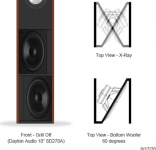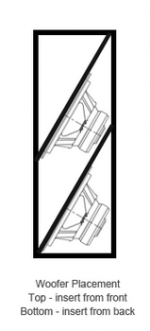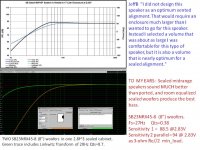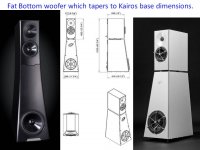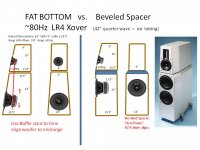I'm about to purchase and build the Kairos Satori monitor kit designed by Jeff Bagby and available from Meniscus. They've received very high praise, particularly in the midrange. But I really like that low end acoustic bass, kick drum, and a bit of electronic music.
I'm planning to supplement the Kairos with two bass "modules" that will double as stands. That means the width is limited to 9". The depth and height are flexible.
The question is: what's the best way to fully integrate this? Money is, of course, a factor, but I want something that will live up to the quality of the top end. These will be equalized with MiniDSP and powered by either 2 plate amps or some kind of multichannel class D amp.
I don't have a home theater, so full volume at 20hz is not a concern. But I would like musical, fast, resonant bass. I think that means an f3 in the high 30s, low 40s.
Options:
I'm planning to supplement the Kairos with two bass "modules" that will double as stands. That means the width is limited to 9". The depth and height are flexible.
The question is: what's the best way to fully integrate this? Money is, of course, a factor, but I want something that will live up to the quality of the top end. These will be equalized with MiniDSP and powered by either 2 plate amps or some kind of multichannel class D amp.
I don't have a home theater, so full volume at 20hz is not a concern. But I would like musical, fast, resonant bass. I think that means an f3 in the high 30s, low 40s.
Options:
- Two vented 28L cabinets with 8" drivers (Seas Cd22, Peerless Nomex...)
- Two subwoofers with 10 or 12" side-mounted drivers (Dayton, most likely)
- Two Ripoles (helps on the width factor).
A small to medium sized living room, which opens onto a larger dining room, kitchen. I have one chair in the sweet spot. Stereo, unless I'm listening to mono LPs, of course.
If it's just you, then the best method is stereo dipole NEAR-FIELD. It doesn't even have to be a large woofer.
As you enter into the near field of a woofer the lower end becomes more pronounced. About half a meter from your head (on either side) should be good.
The results are perceptually better, objectively better, and even has the added bonus of much lower spl leakage into other rooms.
As you enter into the near field of a woofer the lower end becomes more pronounced. About half a meter from your head (on either side) should be good.
The results are perceptually better, objectively better, and even has the added bonus of much lower spl leakage into other rooms.
You mean something like this?

To be clear, I'm looking for something that will fit under the Kairos, so ~ 9" wide, 25-40" high. I'm sure it sounds great, but half meter on either side from my head wouldn't work.

To be clear, I'm looking for something that will fit under the Kairos, so ~ 9" wide, 25-40" high. I'm sure it sounds great, but half meter on either side from my head wouldn't work.
Several hours later, I'm beginning to think I need to consider these various dipole implementations. M/H/Z/S frame?
*borrowed from Gainphile and a long discussion of narrow dipoles on HTguide
*borrowed from Gainphile and a long discussion of narrow dipoles on HTguide
Attachments
You mean something like this?

To be clear, I'm looking for something that will fit under the Kairos, so ~ 9" wide, 25-40" high. I'm sure it sounds great, but half meter on either side from my head wouldn't work.
No.. more like a single 8" driver in an open frame covered with "stretch" fabric and placed on side/end tables next to your listening chair. Basically a small "book end" look that you can remove after listening.
I realize you are contemplating a pedestal format.. I was just trying to offer an alternative that is substantially superior. 😉
As for a loudspeaker pedestal/stand - a good dipole would work.. perhaps copying SL's LX521 (though preferably with a grill cloth):
LX521 Description
The Madisound Speaker Store
..looks pretty good in walnut veneer IMO:
http://www.diyaudio.com/forums/multi-way/223454-new-linkwitz-lx521-speakers-56.html#post3843089
Last edited:
I'd recommend a side-firing Peerless SLS10 or 12 in a closed box. For power and processing you could EQ and power each side with a single miniDSP ICEpower plate amp, or Hypex plate amp. Even the Ice 125ASX2 will provide adequate power for everything in that setup.
http://www.diyhifisupply.com/files/Crescendo%20Manual%200.9.pdf
Ive build those subwoofers. they go deep and sound good and is the perfect size for your needs. Its a TL subwoofer. you can put whatever driver size but the maximum could be 10inch. maybe contact the site to know if thsoe subs can accomodate bigger sub drivers
Ive build those subwoofers. they go deep and sound good and is the perfect size for your needs. Its a TL subwoofer. you can put whatever driver size but the maximum could be 10inch. maybe contact the site to know if thsoe subs can accomodate bigger sub drivers
Last edited:
TO MY EARS: Sealed midrange speakers sound MUCH better than ported, and room equalized sealed woofers produce the best bass.
TWO SB23NRX45-8 (8”) woofers in one 2.8f^3 sealed cabinet Qts=0.7, F3=52Hz BEFORE Linkwitz Transform produces 20Hz Qts=0.7 PLUS required room equalization.
JeffB "I did not design this speaker(Kairos) as an optimum vented alignment. That would require an enclosure much larger than I wanted to go for this speaker. Instead I selected a volume that was about as large I was comfortable for this type of speaker, but it is also a volume that is nearly optimum for a sealed alignment."
SB23NRX45-8 (8”) woofers.
Fs=27Hz Qts=0.38
Sensitivity 1 = 88.5 @2.83V
Sensitivity 2 parallel= 94 @ 2.83V with 4-ohm load
Xmax = 13mm
TWO SB23NRX45-8 (8”) woofers in one 2.8f^3 sealed cabinet Qts=0.7, F3=52Hz BEFORE Linkwitz Transform produces 20Hz Qts=0.7 PLUS required room equalization.
JeffB "I did not design this speaker(Kairos) as an optimum vented alignment. That would require an enclosure much larger than I wanted to go for this speaker. Instead I selected a volume that was about as large I was comfortable for this type of speaker, but it is also a volume that is nearly optimum for a sealed alignment."
SB23NRX45-8 (8”) woofers.
Fs=27Hz Qts=0.38
Sensitivity 1 = 88.5 @2.83V
Sensitivity 2 parallel= 94 @ 2.83V with 4-ohm load
Xmax = 13mm
Attachments
In building the satori monitor, I was planning to mock up a sealed and vented enclosure. I expect Linesource is correct. Sealed will integrate better. JeffBagby says so himself in other threads.
What I've learned so far:
Nearly everyone agrees that some form of EQ is a very good idea.
There is an open debate between sealed and very open designs.
Given my reading yesterday, I'm leaning towards 4 dayton 10" DVC drivers in a Z/W/S frame and a Behringer INuke1000 amplifier for the EQ. But the sealed option is a sure fire bet. I wish there was someone nearby with an "open baffle" bass set-up.
What I've learned so far:
Nearly everyone agrees that some form of EQ is a very good idea.
There is an open debate between sealed and very open designs.
Given my reading yesterday, I'm leaning towards 4 dayton 10" DVC drivers in a Z/W/S frame and a Behringer INuke1000 amplifier for the EQ. But the sealed option is a sure fire bet. I wish there was someone nearby with an "open baffle" bass set-up.
I wish there was someone nearby with an "open baffle" bass set-up.
Open baffle tends to have a cleaner more detailed response, and in particular often has better positioning of bass images within the soundstage. (..they aren't pushed "forward" like most sealed/ported designs).
The down-side is usually physical impact, which often isn't as forceful as a good sealed or ported design. You can improve upon this with higher mass and force (Bl) drivers + amps with high current power supplies.
There are a number of DIY and commercial loudspeakers on Youtube that might well display these qualities (..including the LX521). Recording quality however is often poor. 😱
Given my reading yesterday, I'm leaning towards 4 dayton 10" DVC drivers in a Z/W/S frame and a Behringer INuke1000 amplifier for the EQ.
One argument for monopole woofers below a monopole MT with Xover ~60Hz.
---
The power response of a speaker is the total of both its off-axis and on-axis amplitude response. It is the total acoustical power that is radiated into space. Many believe that the total radiated acoustic power by the speaker system should be constant over as wide a frequency range as possibly, which is only possible if a monopole satellite is mated to a monopole woofer.
Power matching
"The on axis, free space directivity factor for sound sources with several common free space radiation patterns are as follows: Monopole, DF = 1.0, Dipole, DF = 3, Cardioid, DF = 3. What this means is that if these three different sources are to radiate the same total acoustic power then if the monopole has an on axis intensity of 1.0 the dipole and cardioid will have an on axis intensity of 3.0 or 4.77 dB greater. Conversely, if the difference sources are to have the same on axis intensity then the dipole and cardioid will radiate 1/3 the acoustic power of the monopole. (As an aside, for those familiar with room acoustics and reverberation this means that the critical distance from the speaker will be greater for a dipole or cardioid than for a monopole. The critical distance is the distance at which direct and reflected sound are equal. The level of the reflected sound, above the modal region of the room, is usually considered constant and proportional to the total radiated power. Thus when sitting the same distance from a conventional speaker and a dipole, the dipole can potentially sound more detailed since at the position that ratio of direct to reflected sound is greater for the dipole.) Clearly it would appear that if DF is not frequency dependent then a speaker system would radiate constant power from which it would follow that a monopole midrange or satellite speaker should be match with a monopole woofer, a dipole with a dipole and a cardioid with a cardioid. Since cardioids and dipoles have the same DF it would also appear, form a power perspective, that a dipole and a cardioid can also be matched."
That's interesting reading. Thanks. I was talking with an audio dealer the other day describing some new dipole speakers from a well known company. They looked amazing, but he commented that he was having trouble getting them to image just right, as if the top and bottom ends were not in alignment.
More data points, this time from the designer Jeff Bagby:
"...I also have an active system that I listen to these [Kairos] in. It consists of a pair of sealed subwoofers with TC Sounds 12” drivers and separate 500 Watt amps for each, and a 4th order highpass active filter for the 200 Watt Carver amp driving the monitors. I use a 50 Hz high pass for the Kairos with their ports plugged and adjust each of the subwoofer crossovers for frequency, gain, and phase until I get a flat summation
between them and the Kairos. (I use a similar method with other small monitors as well). With the deep bass filtered and the subs dialed-in the Kairos and the dual subwoofers present my room with a powerful and honest musical presentation from 18 Hz to above 20 kHz, that seems to be nearly state of the art for the electronics and room they are being played in..."
For my own reference and possibly others:
http://www.diyaudio.com/forums/multi-way/238592-seas-l26-roy-alternative-3-way.html
http://www.diyaudio.com/forums/subwoofers/253775-single-best-driver-music-sealed-enclosure.html
More data points, this time from the designer Jeff Bagby:
"...I also have an active system that I listen to these [Kairos] in. It consists of a pair of sealed subwoofers with TC Sounds 12” drivers and separate 500 Watt amps for each, and a 4th order highpass active filter for the 200 Watt Carver amp driving the monitors. I use a 50 Hz high pass for the Kairos with their ports plugged and adjust each of the subwoofer crossovers for frequency, gain, and phase until I get a flat summation
between them and the Kairos. (I use a similar method with other small monitors as well). With the deep bass filtered and the subs dialed-in the Kairos and the dual subwoofers present my room with a powerful and honest musical presentation from 18 Hz to above 20 kHz, that seems to be nearly state of the art for the electronics and room they are being played in..."
For my own reference and possibly others:
http://www.diyaudio.com/forums/multi-way/238592-seas-l26-roy-alternative-3-way.html
http://www.diyaudio.com/forums/subwoofers/253775-single-best-driver-music-sealed-enclosure.html
Would a "fat bottom" woofer that tapers up to the Kairos base dimensions fit your design goals? A single sealed 12" woofer could out perform two 8" woofers housed your original 9" wide cabinet limitation spec.
Personally, I would use a paper cone woofer with a cone break-up frequency over 800Hz. Set your price range first, since there are several good options.
Personally, I would never mount a sealed woofer on a angle and bounce its air pressure off of the inside cabinet wall. "Bank shot, piano 27.5Hz low A off the side wall" I would probably try to mimic the Kairos edge bevel on the woofer cabinet for a smooth transistion.
Personally, I would use a paper cone woofer with a cone break-up frequency over 800Hz. Set your price range first, since there are several good options.
Personally, I would never mount a sealed woofer on a angle and bounce its air pressure off of the inside cabinet wall. "Bank shot, piano 27.5Hz low A off the side wall" I would probably try to mimic the Kairos edge bevel on the woofer cabinet for a smooth transistion.
Attachments
That's definitely an option. Yesterday, I spent some time thinking about a box that tapered from 11" at the bottom to 9" at the very top. That would allow for a 10" sub, like the L26 Roy. I'm dealing with a relatively small amount of space - about 1.2 cu ft. But sealed and equalized, that should be okay.
So, I think I'm narrowing to:
Two 10" drivers (one per side) - the L26Roy or a Peerless, Dayton.
Four 8" Drivers (two per side) - the SB23NRX.
They both have their advantages. The larger drivers probably move about as much air, but do so in a coherent manner. But the smaller drivers would make the cabinet easier to build. It's really the cost that's killing me. $400+ dollars for the low end, minus amplification is a lot of money (for me).
So, I think I'm narrowing to:
Two 10" drivers (one per side) - the L26Roy or a Peerless, Dayton.
Four 8" Drivers (two per side) - the SB23NRX.
They both have their advantages. The larger drivers probably move about as much air, but do so in a coherent manner. But the smaller drivers would make the cabinet easier to build. It's really the cost that's killing me. $400+ dollars for the low end, minus amplification is a lot of money (for me).
It's really the cost that's killing me. $400+ dollars for the low end, minus amplification is a lot of money (for me).
..and good amplification can be expensive (..mostly owing to the power supply). 😱
-another option is a T-Line with a single driver (that has a smaller sd, low fs, and good xmax).
This one should work well with eq.:
TC Sounds Epic 8" DVC Subwoofer | 293-657
..perhaps amplified by something like this:
http://www.yuan-jing.com/mono/700w-mono-power-amplifier-board-no-heat-sink
Last edited:
A beveled spacer between the Kairos cabinet and woofer cabinet is another idea to blend two different size boxes. The beveled spacer could be part of the woofer cabinet, or a separate part to simplify the bass cabinet construction. An easy to cut material like blue styrofoam might be easier to prototype than wood or rubber.
Attachments
- Status
- Not open for further replies.
- Home
- Loudspeakers
- Multi-Way
- Adding Bass Module to a Satori Monitor
